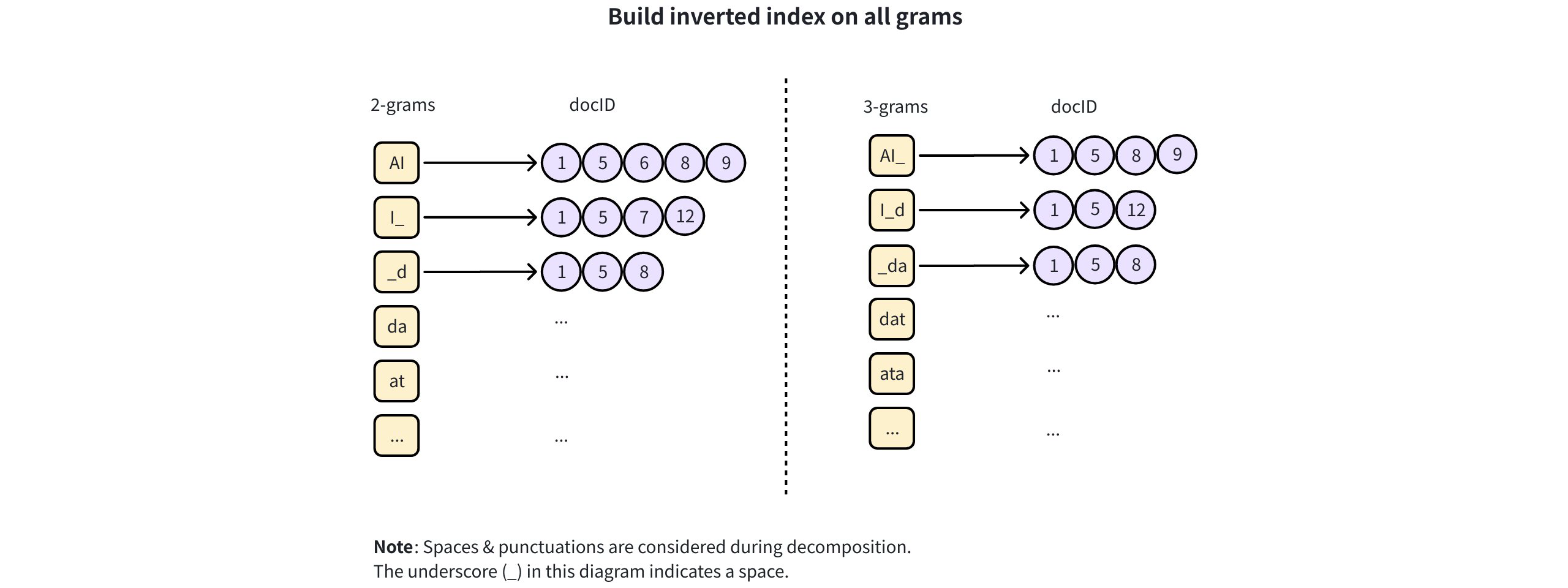NGRAM
在 Zilliz Cloud 中,NGRAM 索引 用于加速对 VARCHAR 字段 或 JSON 字段中指定路径的 LIKE 查询。在建立索引之前,Zilliz Cloud 会将文本拆分为固定长度 n 的 重叠子串(n-gram)。例如,当 n = 3 时,单词 "Milvus" 会被拆分为以下 3-gram:"Mil", "ilv", "lvu", "vus"。这些 n-gram 随后会存储在倒排索引中,每个 gram 都映射到包含它的文档 ID。在查询时,该索引使 Zilliz Cloud 能快速缩小候选范围,从而显著加速查询执行。
当你需要快速进行 前缀、后缀、中缀或通配符过滤 时,使用 NGRAM 索引:
-
name LIKE "data%" -
title LIKE "%vector%" -
path LIKE "%json"
关于过滤表达式语法的更多细节,请参考基本操作符。
工作原理
Zilliz Cloud 以两阶段流程实现 NGRAM 索引:
-
建立索引:在数据写入时,为每个文档生成 n-gram,并构建倒排索引
-
加速查询:在查询时,使用索引筛选出小规模候选集合,再进行精确匹配
阶段 1:建立索引
在数据写入时,Zilliz Cloud 通过以下两步构建 NGRAM 索引:
-
分解文本为 n-gram
Zilliz Cloud 在目标字段的每个字符串上滑动一个长度为 n 的窗口,提取重叠子串。 子串长度由配置范围
[min_gram, max_gram]控制。-
min_gram:生成的最短 n-gram,也定义了查询时能受益的最短子串长度 -
max_gram:生成的最长 n-gram,在查询时也作为拆分长查询字符串的最大窗口大小
示例:当
min_gram=2, max_gram=3,字符串"AI database"被分解为: -

-
2-gram:
AI,I_,_d,da,at, … -
3-gram:
AI_,I_d,_da,dat,ata, …
在
[min_gram, max_gram]范围内,Zilliz Cloud 会生成所有长度的 n-gram。例如[2,4]+"text"→2-gram:
te,ex,xt3-gram:
tex,ext4-gram:
textn-gram 分解基于字符,不依赖语言。例如中文
"向量数据库"+min_gram=2→"向量","量数","数据","据库"空格与标点视为字符参与分解
保留大小写,区分大小写(如
"Database"与"database"生成不同 n-gram)
-
建立倒排索引:构建倒排索引,将每个 n-gram 映射到包含它的文档 ID 列表。
例如,若 2-gram
"AI"出现在文档 1, 5, 6, 8, 9,则索引记录为:{"AI": [1,5,6,8,9]}。

阶段 2:加速查询
执行 LIKE 查询时,Zilliz Cloud 使用 NGRAM 索引按以下步骤加速:

-
提取查询词:从 LIKE 表达式提取不带通配符的连续子串(如
"%database%"→"database") -
分解查询词:根据查询词长度 L 与 [min_gram, max_gram] 拆分:
-
L < min_gram → 索引不可用,回退全表扫描
-
min_gram ≤ L ≤ max_gram → 查询词整体视为一个 n-gram
-
L > max_gram → 按 max_gram 窗口切分为多个 n-gram 示例:max_gram=3,查询
"database"→ 拆分为"dat","ata","tab", …
-
-
查找并取交集:在倒排索引中查找每个查询 gram,并对文档 ID 列表求交集 → 得到候选集
-
验证与返回:对候选集应用原始 LIKE 过滤,得到最终精确结果
创建 NGRAM 索引
可以在 VARCHAR 字段或 JSON 路径上创建 NGRAM 索引。
示例 1:在 VARCHAR 字段上
from pymilvus import MilvusClient
client = MilvusClient(uri="YOUR_CLUSTER_ENDPOINT") # Replace with your server address
# Assume you have defined a VARCHAR field named "text" in your collection schema
# Prepare index parameters
index_params = client.prepare_index_params()
# Add NGRAM index on the "text" field
# highlight-start
index_params.add_index(
field_name="text", # Target VARCHAR field
index_type="NGRAM", # Index type is NGRAM
index_name="ngram_index", # Custom name for the index
min_gram=2, # Minimum substring length (e.g., 2-gram: "st")
max_gram=3 # Maximum substring length (e.g., 3-gram: "sta")
)
# highlight-end
# Create the index on the collection
client.create_index(
collection_name="Documents",
index_params=index_params
)
此配置会为 text 字段中的每个字符串生成 2-gram 和 3-gram,并存储到倒排索引中。
示例 2:在 JSON 路径上
# Assume you have defined a JSON field named "json_field" in your collection schema, with a JSON path named "body"
# Prepare index parameters
index_params = client.prepare_index_params()
# Add NGRAM index on a JSON field
# highlight-start
index_params.add_index(
field_name="json_field", # Target JSON field
index_type="NGRAM", # Index type is NGRAM
index_name="json_ngram_index", # Custom index name
min_gram=2, # Minimum n-gram length
max_gram=4, # Maximum n-gram length
params={
"json_path": "json_field[\"body\"]", # Path to the value inside the JSON field
"json_cast_type": "varchar" # Required: cast the value to varchar
}
)
# highlight-end
# Create the index on the collection
client.create_index(
collection_name="Documents",
index_params=index_params
)
在该示例中:
-
仅
json_field["body"]的值会被索引 -
值在分词前会被强制转换为 VARCHAR
-
Zilliz Cloud 生成 2–4 长度的子串并存储
更多 JSON 字段索引方法请参考 JSON 索引。
NGRAM 加速的查询
NGRAM 索引会被应用于:
-
查询目标为已建立 NGRAM 索引的 VARCHAR 字段或 JSON 路径
-
LIKE 模式中的字面部分长度 ≥ min_gram
支持的查询类型:
-
前缀匹配
# Match any string that starts with the substring "database"
filter = 'text LIKE "database%"' -
后缀匹配
# Match any string that ends with the substring "database"
filter = 'text LIKE "%database"' -
中缀匹配
# Match any string that contains the substring "database" anywhere
filter = 'text LIKE "%database%"' -
通配符匹配
# Match any string where "st" appears first, and "um" appears later in the text
filter = 'text LIKE "%st%um%"' -
JSON 路径查询
filter = 'json_field["body"] LIKE "%database%"'
有关更多信息,请参考基本操作符。
使用须知
-
字段类型:支持 VARCHAR 与 JSON 字段。JSON 必须提供
params.json_path且json_cast_type="varchar" -
Unicode 支持:基于字符分解,与语言无关,包括空格和标点
-
空间–时间权衡:范围越大
[min_gram, max_gram]→ gram 越多 → 索引越大。若内存紧张,可启用 mmap 模式 -
不可变性:min_gram 和 max_gram 无法就地修改,需重建索引
最佳实践
-
选择合适的 min_gram 和 max_gram
-
推荐起点:min_gram=2, max_gram=3
-
min_gram 设置为用户可能输入的最短字面量长度
-
max_gram 设置为常见有效子串的典型长度(越大 → 过滤更精确,但索引更大)
-
-
避免低选择性 grams
如
"aaaaaa"这类模式,过滤效果差 -
保持一致的归一化处理
如果需要(如小写化、去除空格),请在写入与查询时保持一致